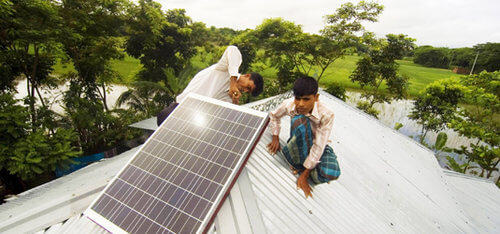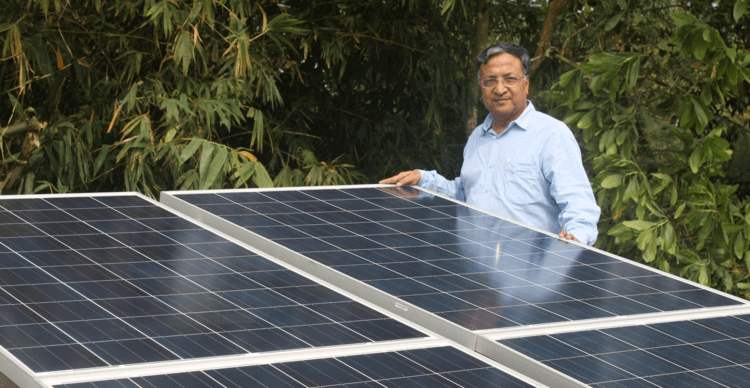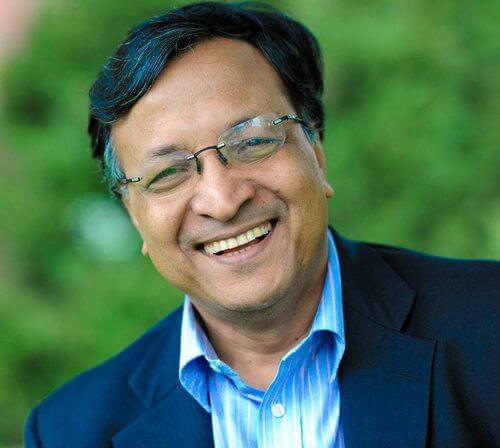Guest Post, by Dipal Chandra Barua
For two decades, Bangladesh has been the testing ground for using distributed solar to achieve energy access at scale. The main vehicle for this remarkable experiment has been the unremarkable-sounding Infrastructure Development Company Ltd. (IDCOL), which—in 2004—started to finance a Bangladesh solar home system (SHS) program using the innovative financial and technology packages I designed and implemented as the Founding Managing Director of Grameen Shakti in 1996. Today, this public-private partnership, backed initially by the World Bank and involving more than 60 NGOs and social enterprises, is anything but ordinary, having lifted up an entire generation.
Distributed solar has lit up the country of 150 million, with around 4.5 million systems installed by IDCOL partners. The initiative—the largest rural solar program in the world—connects about 70,000 customers per month, with 12-15 percent of the population using solar in rural, off-grid areas. As a result, distributed solar has become a key pillar of the nation’s energy infrastructure—powering homes, agricultural, schools, clinics, mosques and street lights. In the process, rural communities have become highly energy literate on the benefits of solar, creating a breakthrough in national mindset.
With the international community committed to achieving universal energy access within 13 years, the learnings from IDCOL can benefit all of the world’s energy-poor countries and their 1.1 billion people still living without electricity, especially in Sub-Saharan Africa where distributed solar (rooftop and micro-grids) will be the leading edge of eradicating energy poverty.
The Bangladesh solar revolution happened because IDCOL, a government-owned non-banking financial company under the central bank, provided one channel for dispersing financial support from international donors and multilateral development banks. This “wholesale” model unified an otherwise fragmented market, standardizing technology, finance and policy. The result: scale.
But much has changed in the last 20 years. The power market is evolving rapidly in Bangladesh, and the government has targeted having 100 percent electrification by 2018 and is now pushing for grid extension at the rate of over 300,000 connections per month to ensure that happens—with the Rural Electrification Board (REB) currently connecting 100,000 customers a month to the central grid.
With so much change, it is only natural that the IDCOL model must evolve too, as must government policy and regulation in order to ensure an integrated approach that recognizes the importance of distributed renewable energy (DRE) solutions and their complementary and essential role to grid electrification.
Other developing countries too can benefit from IDCOL’s financial model. While every country requires a customized approach to energy access—Ethiopia, for example, has 60 million fewer people than Bangladesh, but is four times bigger—many of the lessons are transferable and provide an unprecedented chance to incorporate learnings into the energy access policies.

Key Lessons:
Technology
- Raise awareness: Today everyone in Bangladesh knows about solar energy but 20 years ago, even the electrical engineers had not heard of it. In any market-based DRE program, raising awareness about the benefits of off-grid technologies, and highlighting their links to health, safety and connectivity will be fundamental to creating a strong market.
- Capitalize on innovation: When IDCOL started financing SHS in 2004, a solar panel cost $7 per pico-watt and pre-paid solar software was not available. Now a pico-watt costs less than 50c, and pay-as-you-go solar is being rolled out across East Africa, with many systems GSM-enabled and remote controlled—and there is room for design to get even smarter. New programs should make the most of emerging innovations.
- Use the right technology for the environment: Countries should use today’s knowledge and experience to assess the best technologies for any given region or situation—whether solar, hydro or hybrid systems, or DRE for new applications such as solar for clean water.
- Maximize use of new appliances and applications: LEDs have already been a game changer, freeing solar panel capacity for uses beyond phone charging and lighting, now the market for efficient fans, televisions and fridges is emerging. Programs should maximize the potential of new appliances and applications.
Affordability
- Products must be affordable: From the beginning, the financial model in Bangladesh was designed so customers paid a monthly installment for power—emulating the approximate amount spent on kerosene and making a solar home system affordable. Today, DRE products in other countries have been made even more accessible by pay-as-you-go financing and mobile banking. Initiatives should adapt to innovation to help more people access clean energy solutions. For example, this month (March 2017), the use of PAYG technologies will become mandatory for those organizations receiving IDCOL’s financial support in Bangladesh.
- Competition and cost reduction is vital, but so too is consumer protection: In the last few years, the world price of solar has radically reduced. Now, anyone can import solar products into Bangladesh. This has helped to increase competition and dramatically improve cost to consumers, but it has also led to an influx of low quality goods. Regulations must be in place to protect consumers from substandard products and services.
Program Finance
- Always seek economies of scale: An ambitious country-led initiative provides an immediate opportunity for cost-effective financing—selling 1 million systems makes solar cheaper than selling 100,000. Countries have a great opportunity to reduce costs across the board through by considering scale in program design.
- Prepare for the long term: Any support mechanism needs to be financially sound throughout the value-chain, and able to adapt to changing markets. For example, when IDCOL first started, a 50 percent down payment on a system was required, with the rest paid over six months. Today, it is 15 percent down payment with payback in up to 36 months. However, as the price of products has come down rapidly, there are now customers who don’t want to pay for their long-term instalments as they are comparatively expensive—if you bought your system four years ago it cost around 40 percent less, and prices continue to fall every day. Financial mechanisms must be created with long-term contingencies in mind.
- Concessionary finance is key, so too is planning for when it runs out: We started the IDCOL initiative with the support of the World Bank, then a few years later the JICA, ADB, KfW, Islamic Development Bank (IDB), UNDP, DFID, GIZ and UKAid began financing the program, and helped to build the capacity of the private sector. Concessionary finance is vital to help a market grow but it is also important to consider how support can be reduced, redirected, or built on as the market changes.
Planning
- Consider multiple agencies: In Bangladesh, IDCOL enabled donor support to be channeled to the sector through financial grants, subsidies and refinance, and was built to include the private sector to optimize competition and financing. Because of this joined-up framework and regular flow of financial support, the solar program could reach millions of homes and businesses. Yet having just one agency at the center of a country-wide program can also stifle innovation. An IDCOL-like initiative in another country might benefit from creating competition amongst financing agencies as well as implementation partners.
- Integrated energy planning is pivotal: In Bangladesh, the central grid is now being subsidized and rapidly extended, resulting in some customers no longer wanting to pay for solar, and conflicting interests between the central-grid and distributed grid sectors. Strong, coordinated planning and regulation will avoid many of the issues now being seen in Bangladesh, and can enable the early integration of other DRE technologies, such as solar water pumps, into energy access initiatives.
Training & Jobs
- An IDCOL-style program will be a jobs-engine and provides a way to boost employment of women: In Bangladesh, IDCOL has created hundreds of thousands of new jobs, and implementing partners have also trained thousands of women to assemble, repair and maintain solar products—boosting their income.
- An entrepreneur model can enhance long-term sustainability: The IDCOL model was dependent on a central workforce. In future iterations, this could be replaced by a streamlined, ‘entrepreneur-based’ network where, rather than having thousands of staff employed directly by implementing partners, knowledge is transferred to local entrepreneurs—unlocking the potential of local businesses without creating large overheads for distributed solar companies or NGOs. By training one or two people in each village, you can build a base of skilled technicians who can handle the installation of new systems and address any technical problems in their own communities—providing rapid customer service and reducing costs.
--
It took Bangladesh 7-8 years to install 10,000 solar home systems, but by 2008-9, we were installing more than 10,000 a week, and now we are exploring how to integrate DRE systems into the centralized grid, looking to replace 65,000 traditional diesel pumps with solar water pumps, and piloting the use of solar energy to produce arsenic free drinking water plants. One of the greatest outcomes of IDCOL is that a myth has been broken: now no one feels that renewable technologies are too expensive or too high tech for rural communities.
From the key innovation of an instalment based financial model, solar became affordable, the IDCOL program was established, and 20 million people in Bangladesh are receiving the benefit of SHS in off-grid areas of the country. Today, we have a great opportunity to accelerate energy access via DRE even further, by learning from IDCOL’s successes and challenges and creating new, and better energy access models.
In Bangladesh, our ultimate goal is to get 100 percent of people using renewable energy, and to make the country the world’s first solar nation. With centralized and decentralized assets working seamlessly together we can build on what we have learned, and drive innovation. An IDCOL 2.0.

